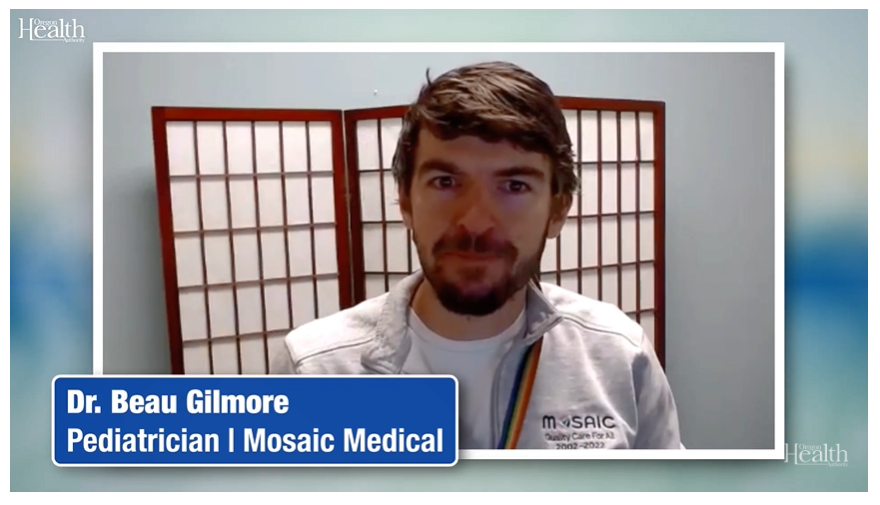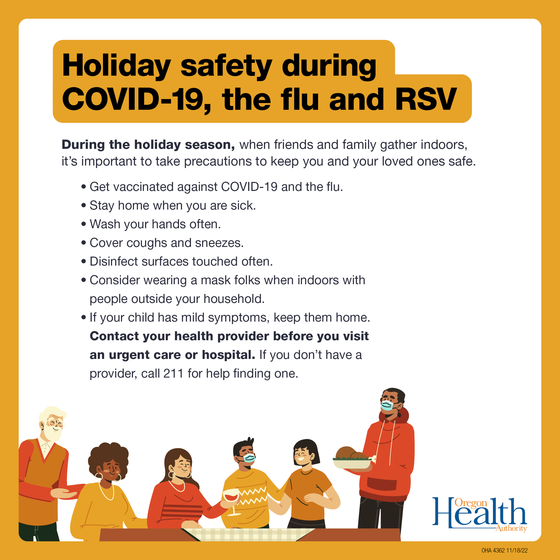|
November 18, 2022
Media Contact: Jonathan Modie, 971-246-9139, PHD.Communications@oha.oregon.gov
As Oregon emergency departments overflow, health officials offer tips for keeping loved ones healthy
PORTLAND, Ore. – An increase in severe respiratory infections this season is putting pressure on Oregon’s already-strained hospitals as the holidays approach. But health officials say people can take simple steps to avoid exposure – and the need for an emergency department visit – as they gather for celebrations.
“We want people to remember the holidays as a festive time of family, friends, food and fun events, not because of a severe case of RSV or other respiratory virus,” said Dana Hargunani, M.D., M.P.H., a pediatrician and Oregon Health Authority’s chief medical officer. “Common-sense vigilance this season can help keep you and your loved ones safe and out of the hospital.”
Beau Gilmore, M.D., pediatrician and chief informaticist at Mosaic Medical in central Oregon, shares his thoughts on staying safe during the holidays in a video on OHA’s YouTube channel. Gilmore also offers advice for parents and caregivers on how to know when to go to the hospital.
 According to OHA data as of Wednesday, the RSV hospitalization rate for children nearly quadrupled between Oct. 29 and Nov. 5, from 2.2 to 8.7 per 100,000 population. The rate dropped slightly by Nov. 12, to 5.7 per 100,000, but that was still double what it was two weeks earlier.
RSV hospitalization rates for adults have been lower, although there remains a risk of serious illness for older adults.
“Emergency departments in Oregon are overflowing,” Hargunani said. “We need to make sure families have access to the emergency care they need when facing serious, life-threatening medical emergencies”
OHA offers the following tips for staying healthy and avoiding an unnecessary hospital visit during the holidays:
- Get a flu shot and stay up to date on COVID-19 vaccinations, including new bivalent boosters.
- There is no vaccine or treatment for RSV, but people can protect themselves by covering coughs and sneezes, cleaning high-touch surfaces, and regularly washing their hands with soap and water or using hand sanitizer.
- Consider wearing a mask during indoor holiday gatherings and events. Anyone at risk for getting severely ill from RSV – young children and older adults– should consider wearing a mask when indoors with people who are not in their household.
- Because children younger than 2 are too young to safely wear a mask, parents and caregivers should consider asking those around them to wear a mask.
Hargunani emphasizes that RSV is a common respiratory virus that usually causes mild, cold-like symptoms, such as runny nose, coughing and sneezing. Most infections go away on their own in a week or two. Almost all children will have had an RSV infection by their second birthday, she said.
People experiencing mild symptoms of RSV should:
- Stay home from work or school, and avoid holiday gatherings and events.
- Manage fever and pain with over-the-counter fever reducers and pain relievers.
- Drink plenty of fluids to prevent dehydration.
- Make sure to talk to your health care provider before giving your child over-the-counter cold medicines which are typically not indicated for this age group.
However, parents and guardians should immediately seek health care if their child is experiencing more severe symptoms of RSV, such as trouble breathing, dehydration, gray or blue color to the tongue, lips or skin, or significantly decreased activity and alertness.
“Over the holidays, it is especially important that we maintain the vigilance that served us so well during the COVID-19 pandemic,” Hargunani said. “Get vaccinated, avoid large gatherings and wear a mask in crowded indoor places. Doing so will help us all have a happy and positively memorable holiday season.”
Monthly COVID-19 reports released
OHA’s COVID-19 Monthly Data Report, released Nov. 10, shows a decrease in COVID-19-related hospitalizations and deaths.
OHA reported 13,433 new cases of COVID-19 in October, a 27% decline from the 18,412 cases recorded in September.
During October, test positivity was 7.3%, down from 8.8% in September.
This month’s COVID-19 Congregate Care Setting Outbreak Report shows there were 100 active outbreaks in care facilities, senior living communities and congregate care living settings, a decrease from the prior month.
OHA publishes annual hospitalization review
OHA last week released its Oregon HOSCAP COVID-19 Review: April 2021–April 2022. The report covers the second year of data collected by hospital staff about hospitalized patients who tested positive for COVID-19, as well as hospital bed capacity. The Oregon Hospital Capacity Web System (HOSCAP), which predates COVID-19, has been used throughout the pandemic by hospitals, health systems and state health authorities for health planning and responding to the COVID-19 pandemic.
The report, published Nov. 8, has several findings:
- Oregon experienced three waves of COVID-19-positive hospitalizations between April 2021 and April 2022, with higher patient counts during the latter two surges than during any prior surge.
- The number of COVID-19-positive hospitalized patients peaked on Sept. 1, 2021, at 1,178 patients (more than double any previously recorded census).
- On average, Oregon hospitals cared for 497 COVID-19-positive patients each day throughout the year, including an average of 115 COVID-19-positive ICU patients. The daily average for the previous reporting year was 200 COVID-19-positive patients (52 in ICU).
- Hospital bed capacity constraints were widespread, and particularly persistent for adult non-ICU beds. Overall adult bed occupancy reached the highest reported level on Jan. 5, 2022, when 95% of adult ICU and non-ICU hospital beds were occupied.
Hospital capacity data are published each Wednesday on OHA’s COVID-19 Data Dashboards.
 ###
 You are subscribed to Oregon Health Authority News Releases. View all OHA news releases.
|